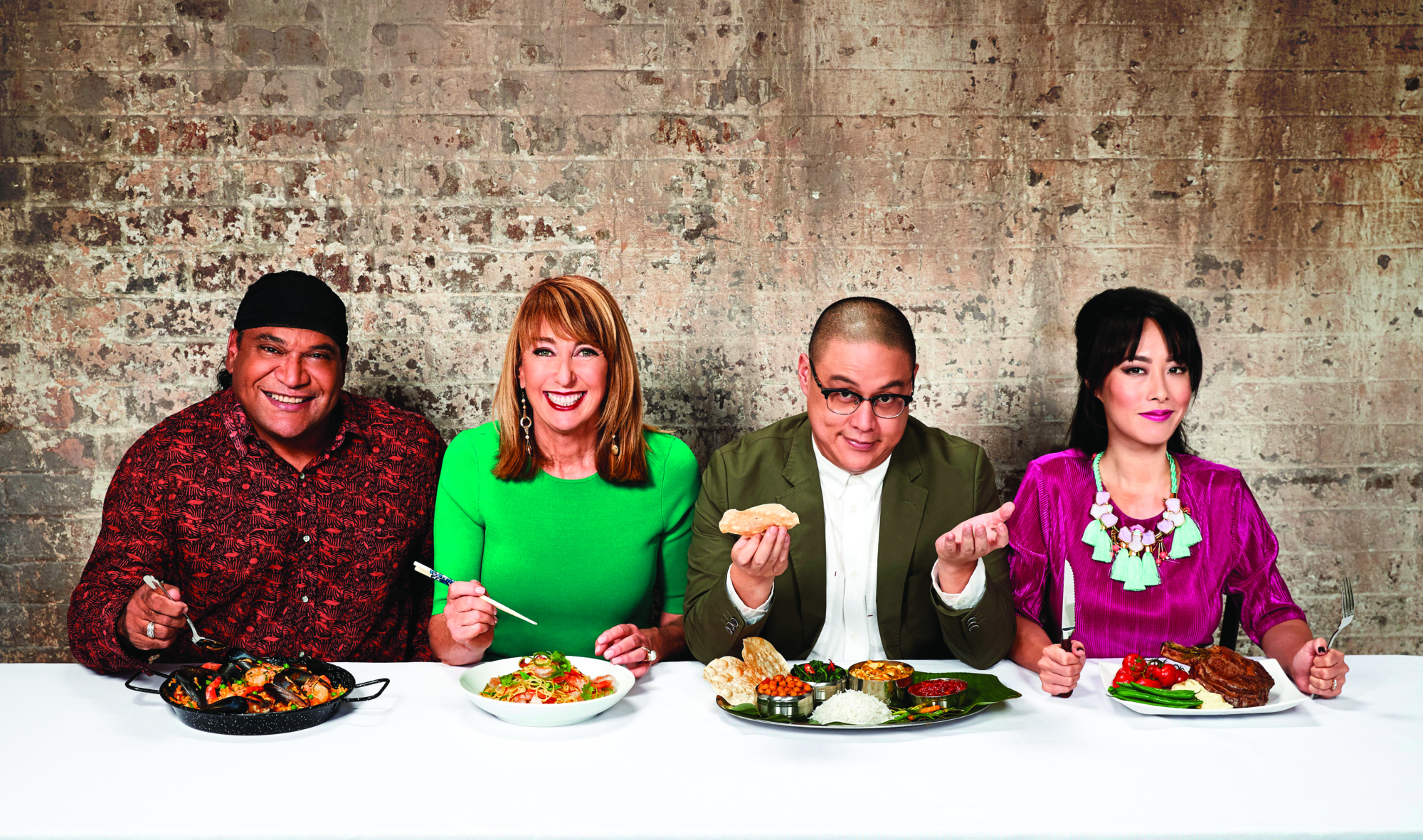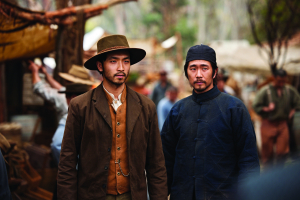Food has been a key way through which ethnic minorities have established a public platform for themselves, elevated their voices and morphed into household names in Australia and abroad. Chef Poh Ling Yeow, who is of Chinese-Malaysian descent, shot to stardom in 2009 after she finished as runner-up of the first season of MasterChef Australia. Following this achievement, she landed an ABC cooking show, Poh’s Kitchen, and published an eventual bestseller, Poh’s Kitchen: My Cooking Adventures. Chef Adam Liaw, of Chinese-Malaysian and English heritage, went one step further and won MasterChef Australia’s second season in 2010, after which he released several cookbooks and began hosting his own show on SBS, Destination Flavour. Vietnamese-Australian chef and restaurateur Luke Nguyen is well known as the host of TV shows Luke Nguyen’s Vietnam and Luke Nguyen’s France. Peter Kuruvita, an Australian chef of Sri Lankan descent, used his acclaimed Sydney restaurant Flying Fish as a launchpad for TV shows and cookbooks. Chinese-Australian chef Kylie Kwong achieved widespread acclaim when Penguin published her first cookbook, Kylie Kwong: Recipes and Stories, in 2003. And, while Indigenous success stories are few and far between compared to the increasing prominence of their Asian-Australian counterparts, Indigenous chefs such as Mark Olive and Clayton Donovan – the latter of whom presents ABC show Wild Kitchen – are also reaching celebrity status, while also promoting the native ingredients and traditional methods that underpinned Aboriginal cuisines for thousands of years before white settlement.
Nevertheless, food remains a fraught arena in Australia’s postcolonial society; ethnicity and the act of eating intersect in oft-problematic ways. Food is a means of survival and sustenance, but it is also an exceedingly political space for those who have endured systemic oppression. Despite the burgeoning of culturally diverse food shows and cooking celebrities alike, it seems that ‘[a] pie and tomato sauce, Vegemite toast and lamingtons’[1]Angela Saurine, ‘How Aussie Chefs Are Making Indigenous Food Cool’, The Daily Telegraph, 7 July 2015, <http://www.dailytelegraph.com.au/lifestyle/food/sydney-taste/how-aussie-chefs-are-making-indigenous-food-cool/news-story/d06022471d69e938946d3b4d3820d7c7>, accessed 24 July 2017. still come to mind for many when discussing ‘Australian’ food – a misnomer when you consider the array of First Nations peoples’ foods as well as those of the various cultural groups that have called Australia home since the first wave of non-white migration during the 1850s gold rush. Internationally, the definition of what constitutes Australian food appears to be as obfuscated as it is here – Indian television star Sanjeev Kapoor made headlines in 2014 when he criticised the gourmet ‘multicultural’ food showcased as part of an Australian tourism campaign that he was recruited for. ‘Do I go to India because you get Chinese food? No. You focus on the variety of Indian food that you get there,’ Kapoor said,[2]Sanjeev Kapoor, quoted in Michael Atkin, ‘Indian Celebrity Chef Sanjeev Kapoor Labels Australia’s Multicultural Gourmet Tourism Strategy “Not Very Smart”’, ABC News, 18 November 2014, <http://www.abc.net.au/news/2014-11-17/food-wine-tourism-campaign-lost-opportunity-sanjeev-kapoor-says/5897782>, accessed 24 July 2017. simultaneously misunderstanding and discounting the tapestry of cultures that make up Australia.

SBS’s The Chefs’ Line goes some way towards resolving this cultural dilemma by representing the heritage, history and diversity that drive Australian food culture. On one level, the show subverts the classic format of shows such as MasterChef – whereby racially diverse home cooks’ creations are judged by a line-up of esteemed, mostly white chefs – by virtue of its exclusively non-white judging panel: Olive, Singaporean-Australian food writer Melissa Leong and Vietnamese-Australian executive chef Dan Hong. On a more significant level, the series focuses its attention on non-Anglo cuisines: Vietnamese, Chinese, Thai, Indian and Japanese feature alongside African, Turkish, Italian, Greek, Lebanese, Spanish, Mexican and French. Notwithstanding the series’ use of the monolithic term ‘African’ to describe an entire continent’s cuisine – you’d never find the distinct Asian cuisines of Vietnam, China, Thailand, India and Japan conflated under the same umbrella in this sort of programming – The Chefs’ Line’s spread of cuisines is an admirable one that aptly captures the cultural melting pot that is Australia. A different cuisine is showcased every week, with four home cooks battling against four trained chefs from an acclaimed Australian restaurant serving up that same cuisine. As showrunner Chris Culvenor describes it, The Chefs’ Line is a ‘celebration of the diversity of Australian food culture’,[3]Chris Culvenor, quoted in James Whitton, ‘A Look at SBS’ New Competitive Cooking Series, The Chef’s [sic] Line’, Concrete Playground, 9 April 2017, <https://concreteplayground.com/melbourne/food-drink/food-2/a-look-at-sbs-new-competitive-cooking-series-the-chefs-line/>, accessed 24 July 2017. while Leong herself observes that the show ‘challenge[s] whose faces programmers think [Australians] want to see on the screen’.[4]Melissa Leong, ‘The Chefs’ Line: On Air Now on SBS!’, Fooderati, 19 April 2017, <http://www.fooderati.com.au/news/2017/4/19/the-chefs-line>, accessed 1 August 2017.
Picking from whose garden?
Although traditional Indigenous ingredients – such as the finger limes used in Vietnamese-Australian home cook Thanh Truong’s nuoc cham – are incorporated into different cultures’ cuisines in fresh and innovative ways, not one of the show’s weeks is dedicated to Indigenous cooking. In a 2015 interview, Olive himself called out the relative obscurity of Indigenous foods in Australia, especially when compared to the large quantities of Thai, Indian and Japanese food exports and when contrasted with the increasing prominence of bush foods in the international gastronomy scene:
Indigenous food is food that’s grown in Australia, comes from Australia and that Aboriginal people ate and utilised during their time on the land […] Chefs around the world are embracing it and are so curious about it.[5]Mark Olive, quoted in Saurine, op. cit.
Indeed, as Chinese-American journalist Clarissa Wei has asserted, the foods of minority cultures only receive mainstream acceptance once the white majority says so: ‘Growing up, I was the weird kid who adored boiled pig intestines and fermented tofu. So imagine my surprise when the 2000s hit and the food of my people was suddenly cool.’[6]Clarissa Wei, ‘The Struggles of Writing About Chinese Food as a Chinese Person’, VICE, 25 April 2017, <https://munchies.vice.com/en_us/article/yp7bx5/the-struggles-of-writing-about-chinese-food-as-a-chinese-person>, accessed 24 July 2017. Western cultural imperialism occupies a stronghold in the food arena, hegemonically dictating minorities’ production and consumption of their own food. In the case of Indigenous cuisine, prominent food professionals have started patenting bush foods without fairly remunerating the Indigenous women who forage for the required ingredients; Dick Smith now produces a Bush Foods Breakfast cereal; and hipster culture has precipitated an upsurge in the ‘urban foraging’ of bush food.[7]Nicole Hasham, ‘Bush Tucker Trend: Indigenous Custodians Call for Protections on Native Foods’, The Sydney Morning Herald, 19 December 2015, <http://www.smh.com.au/national/bush-tucker-trend-indigenous-custodians-call-for-protections-on-native-foods-20151218-glrcb2.html>, accessed 24 July 2017. More insidiously, non-Indigenous chefs such as Paul Cooper at Surry Hills restaurant Bishop Sessa are incorporating Indigenous ingredients such as wild rosella fruit and lemon myrtle into their menus to widespread acclaim, without any recompense extended to Indigenous communities.[8]Saurine, op. cit.
Ethnicity and the act of eating intersect in oft-problematic ways. Food is a means of survival and sustenance, but it is also an exceedingly political space for those who have endured systemic oppression.
The commodification of bush foods that Indigenous people have lived on for millennia is problematic at best – but, when it isn’t accompanied by respectful engagement or an examination of the political, historical and cultural conditions under which these foods are produced, it morphs into something more destructive than just cultural insensitivity. This is not to say that there are no instances of respectful engagement with bush foods in Australia – Scottish-born chef Jock Zonfrillo, at the helm of Adelaide-based restaurant Orana, recently built on his incorporation of native foods in his restaurant’s menu by setting up a research partnership with the University of Adelaide to ‘foster the research and cultivation of native Australian ingredients for the benefit of remote Indigenous communities’.[9]Madeline Woolway, ‘Jock Zonfrillo’s Foundation Launches New Partnership’, Hospitality Magazine, 4 July 2017, <http://hospitalitymagazine.com.au/chef-launches-native-food-partnership/>, accessed 1 August 2017. Famed chefs such as Alex Atala, René Redzepi and David Chang, who utilise native foods in their restaurants, have sought opportunities to learn more about the sources of these foods from the Indigenous community leaders who forage, cook and eat them.[10]John Lethlean, ‘The Native Chefs Using Local Bush Tucker’, The Australian, 11 July 2017, <http://www.theaustralian.com.au/life/food-wine/the-native-chefs-using-local-bush-tucker/news-story/7b8fa97e0ebb4e4f95dc51edcdbdc75d>, accessed 1 August 2017. And online retailers that specialise in native foods – such as Taste Australia Bush Food Shop and Outback Chef – are helping turn them into staple pantry items instead of something only fine diners experience within the confines of modern Australian restaurants.[11]Anooska Tucker-Evans, ‘Native Ingredients Set to Take Over Qld Kitchens’, The Courier-Mail, 5 July 2017, <http://www.couriermail.com.au/lifestyle/food/qld-taste/native-ingredients-set-to-take-over-qld-kitchens/news-story/ccbda52763083284fb2de207d0bc41e2>, accessed 1 August 2017. These instances of respectful engagement are imperative because, as University of New England postdoctoral research fellow Kylie Lingard has found, ineffectual laws often neglect to protect Indigenous communities’ traditional resources – particularly when bush foods are harvested commercially on private land that was never ceded – and have resulted in ‘a loss of connection between Aboriginal people’s relationship with the food and the person who is developing it’.[12]Kylie Lingard, quoted in Hasham, op. cit.
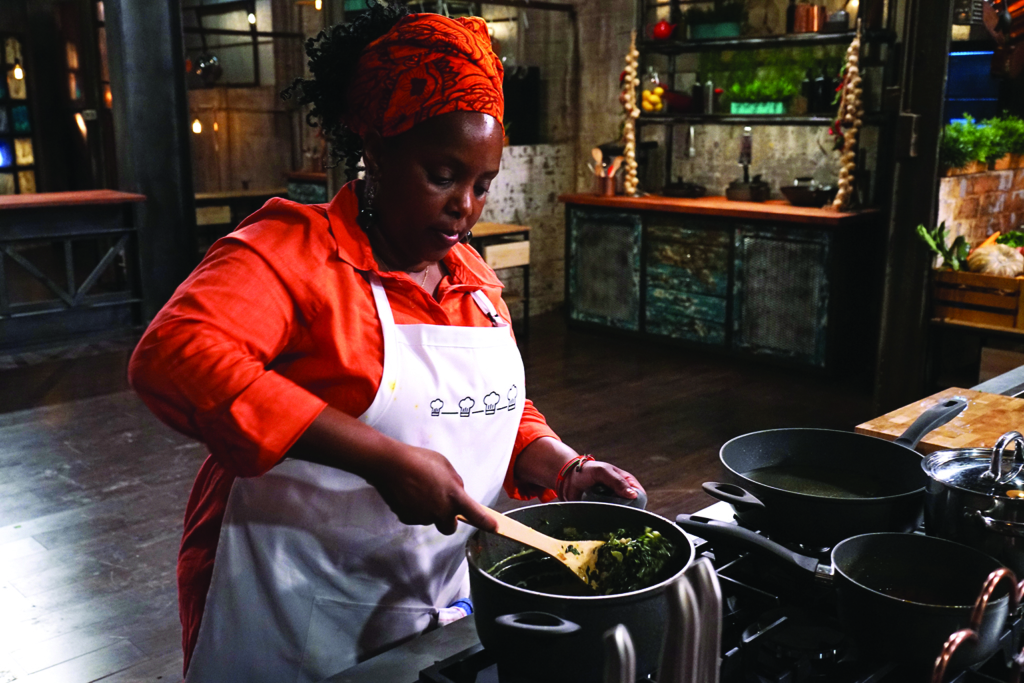
These questions around the loss of a cultural group’s connection with their food when it is commodified within a multicultural society, as well as who is allowed to produce what, are foregrounded when viewing The Chefs’ Line. During ‘African Week’, for instance, each of the four home cooks has African heritage, but South African head chef Duncan Welgemoed is the only member of the professional line-up to have had an understanding of the cuisine that predates his employment at his restaurant, Africola. Conversely, during ‘Turkish Week’, the entire professional line-up comprises chefs of Turkish descent, but only one of the home cooks is Turkish; the other three are white Australians who discovered a love for Turkish cooking at some point in their lives. This disparity comes to the fore when the non-Turkish home cooks make decisions that run contrary to the cuisine itself – Sally Arnold serves a French baguette with her Turkish prawns, while Elianor Gerrard uses spelt flour instead of the traditional regular flour to make simit, a Turkish circular sesame bread.
What becomes quickly apparent upon watching The Chefs’ Line week in, week out, is the tendency for minorities – whether as home cooks or executive chefs – to be restricted solely to the cuisines that they are culturally tied to.
What becomes quickly apparent upon watching The Chefs’ Line week in, week out, is the tendency for minorities – whether as home cooks or executive chefs – to be restricted solely to the cuisines that they are culturally tied to. With the exception of home cooks Vietnamese-Australian Tran Ho Salat, who participates in ‘Thai Week’, and Filipino-Australian Iyan Difuntorum, from ‘Vietnamese Week’ – both of whom employ age-old South-East Asian recipes that have been passed down through their families – it is predominantly the white home cooks who produce food with no immediate connection to their own cultural heritages. Further illustrating this point, during ‘Japanese Week’, ‘Adam from Brisbane’ says that he considers himself a child of the Karate Kid (John G Avildsen, 1984) generation, and that it was this film that propelled his interest in Japanese culture; similarly, during ‘Turkish Week’, Clinton Yudelman recounts that he ‘fell in love with Turkish food on a trip’ and considers his true strength as a cook the fact that he doesn’t stick to tradition.
Seven of The Chefs’ Line’s thirteen executive chefs do not share the cultural background of the cuisine that they each specialise in; of these seven, six are white Australians. Some – like Geoff Lindsay of Vietnamese restaurant Dandelion, who discovered an ‘unlikely affinity with the flavours, aromas and recipes of Vietnam’ during a trip to South-East Asia[13]Siobhan Hegarty, ‘Chef Chats: Geoff Lindsay on Cooking Vietnamese’, SBS Food, 3 April 2017, <http://www.sbs.com.au/food/article/2017/03/27/chef-chats-geoff-lindsay-cooking-vietnamese>, accessed 24 July 2017. – have immersed themselves in the cultures they’re partaking of. But not everyone shares this level of engagement: Tommy Payne of Mexican restaurant El Publico, for instance, is described as having harboured ‘a “meh” attitude […] towards Mexican cuisine’ until just two-and-a-half years ago.[14]Siobhan Hegarty, ‘Chef Chats: Tommy Payne on Cooking Mexican’, SBS Food, 26 June 2017, <http://www.sbs.com.au/food/article/2017/06/26/chef-chats-tommy-payne-cooking-mexican>, accessed 24 July 2017.
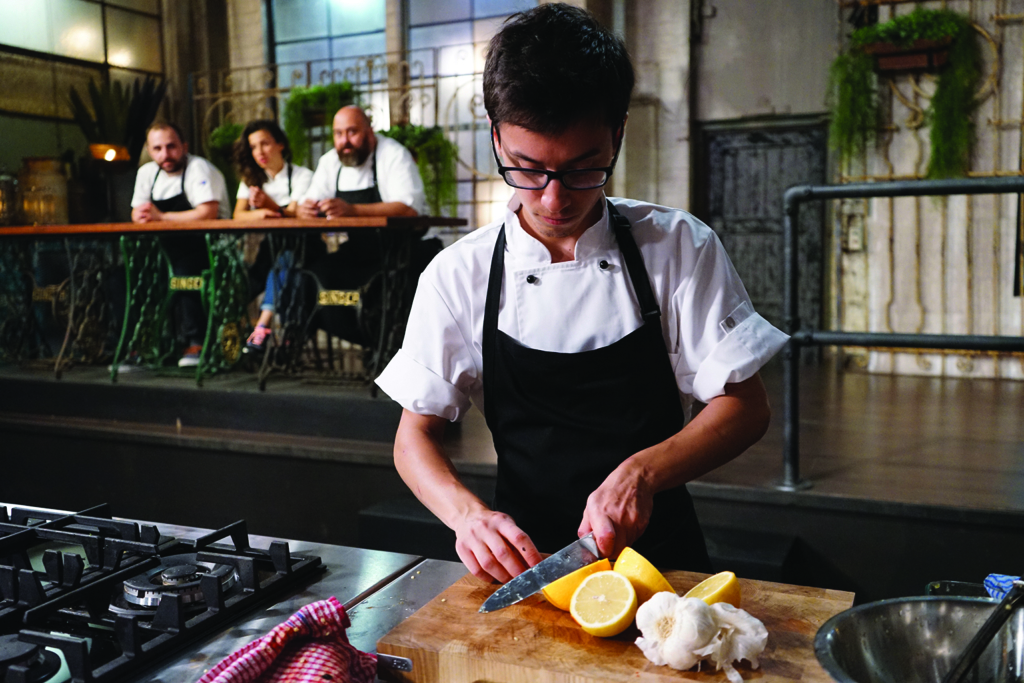
Authenticity in cuisine and criticism
The cultural exchange that often happens in our increasingly interconnected world is an enriching practice – but not when it’s one-way. ‘When I look at the repertoire of work that White chefs and restaurateurs have built on ethnic cuisine,’ writes Toronto-based researcher Lorraine Chuen, ‘it feels in a way, dehumanizing. White people are able to establish outrageously successful careers for being experts and authorities on the stuff that racialized folks do every day simply by existing.’ In ‘Food, Race, and Power: Who Gets to Be an Authority on “Ethnic” Cuisines?’, she quantifies the extent to which white chefs are considered authority figures on the cuisines of other cultures. Analysing The New York Times’ online recipes collection, she discovers that food experts of white descent had authored:
• almost 90 per cent of the 263 recipes categorised as ‘Chinese’
• 90 per cent of the 216 ‘Indian’ recipes
• 95 per cent of the eighty-six ‘Vietnamese’ recipes
• 84 per cent of the seventy-three ‘African’ recipes.
‘I do not doubt that these people are talented chefs,’ Chuen writes.
But here’s the thing: my parents – and every other immigrant – moved to a new country and learned the language, got to know the people, adopted their way of life, simply because they were forced to […] How come we don’t see swaths of immigrants being publicly lauded for culturally assimilating?[15]Lorraine Chuen, ‘Food, Race, and Power: Who Gets to Be an Authority on “Ethnic” Cuisines?’, Intersectional Analyst, 8 January 2017, <http://www.intersectionalanalyst.com/intersectional-analyst/2017/1/7/who-gets-to-be-an-authority-on-ethnic-cuisines>, accessed 24 July 2017.
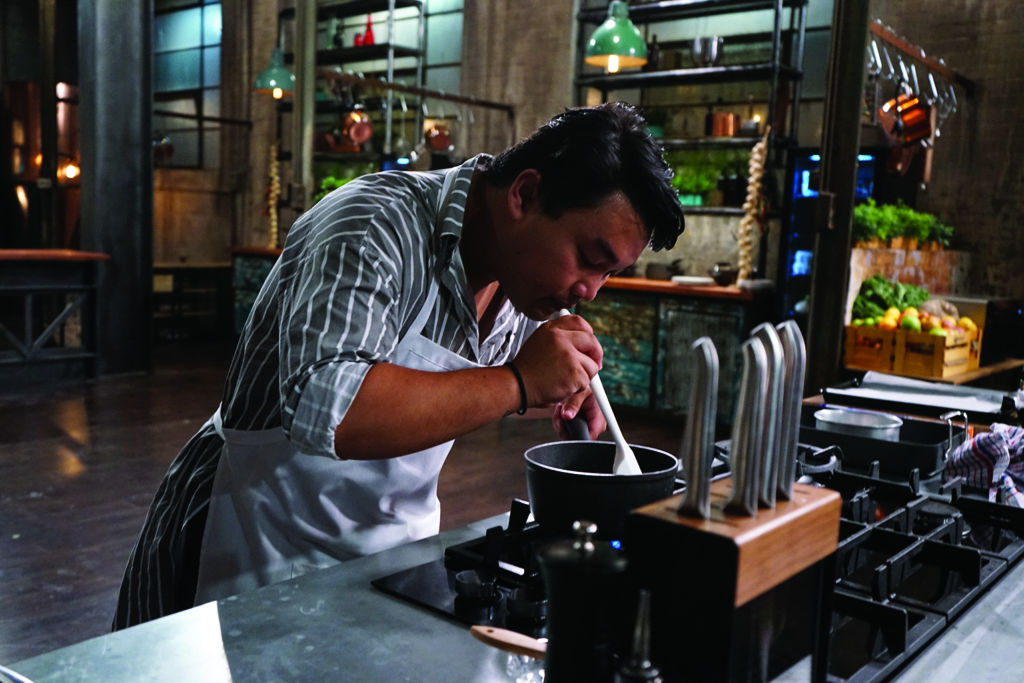
By ensuring that its judging panel is racially diverse, The Chefs’ Line ostensibly sidesteps potential criticisms that could have arisen from having white chefs yet again assume a position of authority while presiding over the foods of different cultural groups. In fact, its judges are well informed about the cuisines that they’re assessing – each taking turns to blind-assess different challenges and comment on the different spices, fragrances and cooking styles they detect in each dish. But certain pronouncements they make wrestle with the broader question of authenticity. ‘Authenticity’ is a game-deciding element that the judges invoke time and time again – Leong eliminates half-Vietnamese home cook Emmylou MacCarthy because her use of Indonesian kecap manis in her pork, cabbage and carrot spring rolls means the dish doesn’t ‘speak with as much of a Vietnamese accent as some of the other dishes’, while Hong chides Truong in the same week for his ‘inauthentic’ use of shrimp paste, a predominantly Malaysian condiment, in his pho.
Authenticity can be an altogether-subjective concept, depending on whom you ask. During ‘Chinese Week’, Evelyn Kwok, a Sydney-based Chinese-Australian academic who grew up in Hong Kong, prepares a whole fish blanketed in a traditionally spicy XO sauce concoction. Olive doesn’t name her the winner, however, because he finds her dish too spicy – calling into question whether the home cooks’ creations are judged according to what is most representative of the relevant culture or what is the most suitable for a mainstream Australian palate. In ‘Eating Multiculturalism’, writer Cher Tan argues that ‘using the word “authentic” to describe particular foods, ways of eating and methods of preparation […] create[s] an ideal that draws a line between what is accepted and what isn’t’. Yet authenticity is
built around white cultural expectations – not the idealised food from a particular country, but rather […] a consequence of intervening years of colonialism, immigration and globalisation. The appreciation and consumption of ‘ethnic’ food then emerges as an indicator for tolerance and cosmopolitanism.[16]Cher Tan, ‘Eating Multiculturalism’, Peril, 16 October 2014, <http://peril.com.au/topics/featured/eating-multiculturalism/>, accessed 24 July 2017.
For all the questions The Chefs’ Line raises about gate-keepers, arbiters and authenticity, it is one of the many racially diverse cooking shows – alongside those hosted by Yeow, Nguyen and Donovan – that are slowly but surely dismantling Australia’s predominantly white conception of itself. The show has already received some praise for its lean format and focus on food over hype, particularly when evaluated against its reality-show counterparts.[17]See, for example, Whitton, op. cit.; and Dayne Rzeszkowski, ‘The Chefs’ Line: The Tasty Cook-off Show Foodies Need to Watch’, The Reel World, 29 May 2017, <https://www.thereelword.net/the-chefs-line-the-sbs-should-watch/>, accessed 24 July 2017. But maybe its true success as a project for diverse representation will be realised once we see it dedicate a week solely to Indigenous cuisine or feature an Indian chef who specialises in Italian cooking.
http://www.sbs.com.au/food/programs/the-chefs-line
Endnotes
| 1 | Angela Saurine, ‘How Aussie Chefs Are Making Indigenous Food Cool’, The Daily Telegraph, 7 July 2015, <http://www.dailytelegraph.com.au/lifestyle/food/sydney-taste/how-aussie-chefs-are-making-indigenous-food-cool/news-story/d06022471d69e938946d3b4d3820d7c7>, accessed 24 July 2017. |
|---|---|
| 2 | Sanjeev Kapoor, quoted in Michael Atkin, ‘Indian Celebrity Chef Sanjeev Kapoor Labels Australia’s Multicultural Gourmet Tourism Strategy “Not Very Smart”’, ABC News, 18 November 2014, <http://www.abc.net.au/news/2014-11-17/food-wine-tourism-campaign-lost-opportunity-sanjeev-kapoor-says/5897782>, accessed 24 July 2017. |
| 3 | Chris Culvenor, quoted in James Whitton, ‘A Look at SBS’ New Competitive Cooking Series, The Chef’s [sic] Line’, Concrete Playground, 9 April 2017, <https://concreteplayground.com/melbourne/food-drink/food-2/a-look-at-sbs-new-competitive-cooking-series-the-chefs-line/>, accessed 24 July 2017. |
| 4 | Melissa Leong, ‘The Chefs’ Line: On Air Now on SBS!’, Fooderati, 19 April 2017, <http://www.fooderati.com.au/news/2017/4/19/the-chefs-line>, accessed 1 August 2017. |
| 5 | Mark Olive, quoted in Saurine, op. cit. |
| 6 | Clarissa Wei, ‘The Struggles of Writing About Chinese Food as a Chinese Person’, VICE, 25 April 2017, <https://munchies.vice.com/en_us/article/yp7bx5/the-struggles-of-writing-about-chinese-food-as-a-chinese-person>, accessed 24 July 2017. |
| 7 | Nicole Hasham, ‘Bush Tucker Trend: Indigenous Custodians Call for Protections on Native Foods’, The Sydney Morning Herald, 19 December 2015, <http://www.smh.com.au/national/bush-tucker-trend-indigenous-custodians-call-for-protections-on-native-foods-20151218-glrcb2.html>, accessed 24 July 2017. |
| 8 | Saurine, op. cit. |
| 9 | Madeline Woolway, ‘Jock Zonfrillo’s Foundation Launches New Partnership’, Hospitality Magazine, 4 July 2017, <http://hospitalitymagazine.com.au/chef-launches-native-food-partnership/>, accessed 1 August 2017. |
| 10 | John Lethlean, ‘The Native Chefs Using Local Bush Tucker’, The Australian, 11 July 2017, <http://www.theaustralian.com.au/life/food-wine/the-native-chefs-using-local-bush-tucker/news-story/7b8fa97e0ebb4e4f95dc51edcdbdc75d>, accessed 1 August 2017. |
| 11 | Anooska Tucker-Evans, ‘Native Ingredients Set to Take Over Qld Kitchens’, The Courier-Mail, 5 July 2017, <http://www.couriermail.com.au/lifestyle/food/qld-taste/native-ingredients-set-to-take-over-qld-kitchens/news-story/ccbda52763083284fb2de207d0bc41e2>, accessed 1 August 2017. |
| 12 | Kylie Lingard, quoted in Hasham, op. cit. |
| 13 | Siobhan Hegarty, ‘Chef Chats: Geoff Lindsay on Cooking Vietnamese’, SBS Food, 3 April 2017, <http://www.sbs.com.au/food/article/2017/03/27/chef-chats-geoff-lindsay-cooking-vietnamese>, accessed 24 July 2017. |
| 14 | Siobhan Hegarty, ‘Chef Chats: Tommy Payne on Cooking Mexican’, SBS Food, 26 June 2017, <http://www.sbs.com.au/food/article/2017/06/26/chef-chats-tommy-payne-cooking-mexican>, accessed 24 July 2017. |
| 15 | Lorraine Chuen, ‘Food, Race, and Power: Who Gets to Be an Authority on “Ethnic” Cuisines?’, Intersectional Analyst, 8 January 2017, <http://www.intersectionalanalyst.com/intersectional-analyst/2017/1/7/who-gets-to-be-an-authority-on-ethnic-cuisines>, accessed 24 July 2017. |
| 16 | Cher Tan, ‘Eating Multiculturalism’, Peril, 16 October 2014, <http://peril.com.au/topics/featured/eating-multiculturalism/>, accessed 24 July 2017. |
| 17 | See, for example, Whitton, op. cit.; and Dayne Rzeszkowski, ‘The Chefs’ Line: The Tasty Cook-off Show Foodies Need to Watch’, The Reel World, 29 May 2017, <https://www.thereelword.net/the-chefs-line-the-sbs-should-watch/>, accessed 24 July 2017. |
